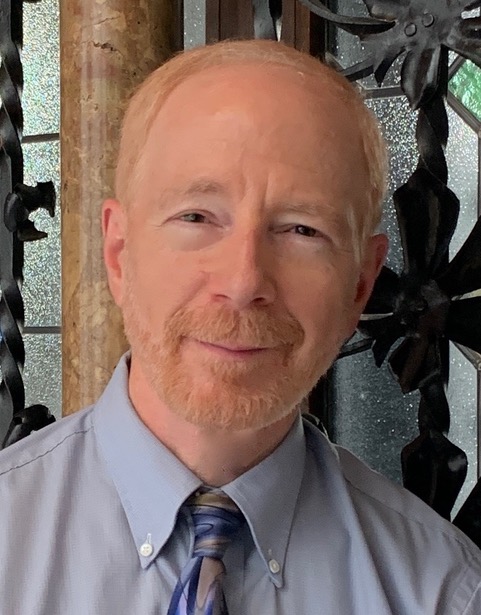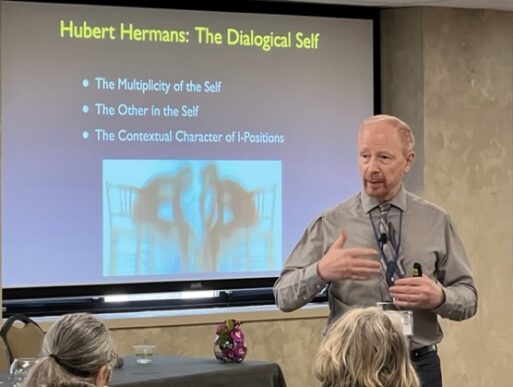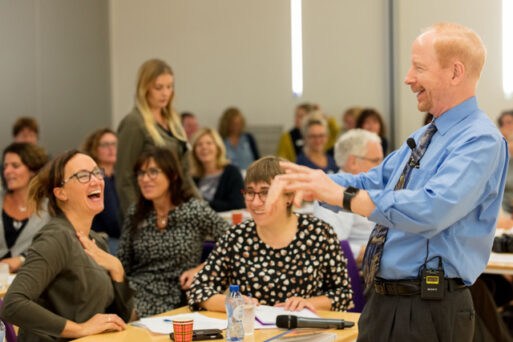
Robert A. Neimeyer, Ph.D.
Robert A. Neimeyer, Ph.D. is the director of the Portland Institute for Loss and Transition, and a recognized expert in grief therapy. A former President of the Association for Death Education and Counseling (ADEC), Neimeyer has also served as the Chair of the International Work Group on Death, Dying, and Bereavement.
Today, SevenPonds spoke with Neimeyer about an upcoming workshop, “Imaginal Dialogues with the Deceased: Principles and Practice,” which he will present with psychologist Carolyn Ng, at the upcoming ADEC conference in Houston, Texas, from April 11-13, 2024. The half-day workshop is meant to help increase awareness about this meaning-focused grief therapy.
Are some clients better suited for imaginal dialogues with the deceased than others?
Yes, that is true with any therapy technique we offer, because it needs to begin with where the client is, not with where the therapist is. At each point in my work alongside a client, I’m trying to discern two things:
- What does my client most deeply need right at this moment? Often that is something not fully verbalized but almost always very observable.
- I ask them how ready they are. For example, they might be very lonely in their bereavement but not ready to take on a new relationship. There needs to be a combination of readiness and need. That’s the sweet spot that makes transformative work possible.
In having an imaginal dialogue with the deceased, there are usually clues that the client is ready, as when a client says, “I just wish I could hear her voice,” or “We never had a chance to resolve a breach in our relationship.” With imaginal conversations, they can.
How does the client construct a dialogue with a deceased person?
Sometimes we write a letter to the deceased, and after processing that in therapy we may also write a letter back from the deceased to ourselves. In grief, particularly, clients tend to struggle with one of three sets of issues or questions they are trying to sort through.
The first is how do they integrate the event story of the loss itself, the sense they make of the loved one’s dying? Was it sudden, such as in a suicide, homicide, or natural disaster? If so then these questions loom very large, and the symptoms they have are often charged with trauma. We need to find how to hold the story without it being retraumatizing in order to make sense and find words for it.
At other times the struggle might come with the backstory of the client’s relationship with the deceased. Was there loneliness, regret, guilt, or anxiety about not having them in their life any longer? Was there unfinished business – unresolved relational issues – that need attention?
We are trying on the one hand to reaffirm a kind of loving continuing bond with the deceased person or problem-solve that unfinished business that stands between us still. When the symptoms and struggles are of that kind, people can often benefit from invoking the relationship in some way, bringing it into the room, so to speak, to update it.
Then there is relational distress that we avoid and never master. We keep holding it in the same troubling way we had since it occurred. From our childhood we carry it forward, and our resentments can fester for a lifetime.
In bereavement, it is much the same: We deal with it by trying not to bring it up. The problem is, we never learn to master the challenges we avoid. To gain perspective, to come to terms with it, we need to revisit it in a way that is safe and feasible.

Robert A. Neimeyer, Ph.D.
Submitted photo
Does the client ask the deceased person to sit in the room with them?
Therapy often promotes time travel. If we think about it, what’s troubling is not in the past but what we carry into the present from the past. If I carry resentment of a deceased parent, I carry those incomplete conversations in my mind. By externalizing that parent, we give them a place and potentially a voice in therapy.
I often ask the client to imagine their loved one might accept an invitation to join us now from a place beyond the physical or emotional pain they carry in their life.
In what ways do you assist the client?
If they say yes, I might have a conversation that goes something like this:
Neimeyer: I wonder if you could begin with me simply by closing your eyes and imagining that your father accepted that invitation you made to him to have a father-son chat that never took place but still needs to. If he were seated in that chair across from you, what do you imagine he would be wearing?
Client: I think a golf shirt.
Neimeyer: What color?
Client: Probably the blue one; it was his favorite!
Neimeyer: What else is he wearing?
Client: He always wore blue jeans when he wasn’t working and his old beat-up tennis shoes.
Neimeyer: And how is he seated in the chair?
Client: He’s kind of leaning back comfortably. Mom always nagged at him about his posture (smiling).
Neimeyer: What do you notice in his expression?
Client: He has a smile, like laughter in his eyes.
Neimeyer: That’s interesting: How does it feel to see him and to see and almost hear that laughter?
Client: It feels really good (tearing up a bit).
Neimeyer: How would you like to tell him how that feels?
And so the dialogue begins with basically invoking in the mind’s eyes that person’s presence more fully. It’s an open dialogue of compassionate understanding. The person talks about things that still haunt them, such as their guilt or regret, and my goal is to clarify and ask them to tell the deceased more about specific things they really regret in their relationship. Then we listen for that pregnant pause, when the person might glance back at me and may ask with their eyes: “What do I do now?”
It’s like what happens in a natural therapy session, for example, between a father and son. The father listens to what his son is telling him right now, expressing a lot of love but regret too. We then give the father a chance to respond. I might ask, “What do you think about that?”
The same sort of dialogue can take place with the client enacting both parts, as I shift him from one chair or position to the other. I encourage the client to talk to the deceased person, rather than about them. Say it directly to him: “Dad, what I need you to understand is… .” You need a real dialogue and the important thing to bear in mind is the way we are put together as biological and psychological beings. Anything we experience as real is also real in its consequences. The nightmare may not be real, but that doesn’t mean it won’t get our hearts beating faster or wake us up in a night terror.
In the same way, if we invoke a conversation with a sense of truth to it, the impact is also equally real. The conflict is maintained in the mind and the imagination, and that is where it needs to be resolved. We are trying to make peace with the internalized father in my example.
It’s not always about trouble, we are often working to say hello again, to carry our deceased parents, partners, children, siblings forward into our changed futures.
Do you always use an empty chair in the sessions and ask the client to move from one chair to the next and act out the deceased person’s role?
In my practice, I prefer the choreographic activity of physically moving the person to the other chair. The very act of externalizing the other and giving the person voice while putting it out there visually also helps with the differentiation of self from father. The two voices become clear, not vague and muddled.
It becomes something that can be teased out like tangled hairs that we find a way of getting a brush through and straightening them. And then we can braid them together into something that is quite beautiful.
Some clients do this in online therapy, and instead of asking them to go into the other chair, I ask them to close their eyes. “Let’s call up father, he’s been listening very intently.”
Do imaginal dialogues with the deceased usually take more than one session?
Some clients need multiple sessions. The aim is rarely to conclude the dialogue with a final goodbye, but rather to reopen a potentially ongoing dialogue. I more often encourage clients to say “see you later” rather than “goodbye,” with the expectation of reconnecting.
Are the results sustainable?
I have found that invoking the presence of the deceased is often the most relevant source of social support for clients in addition to family and friends.
Imaginal dialogues can also take a written form. When you use paper and journaling as a way of continuing the dialogue, clients find ways of distinguishing the two voices. People often change the color of ink from black to blue when they switch positions – or if they’re typing on the computer, they might change fonts or use different colors to represent the different voices. Then they can look at the product and may have further thoughts and bring it into therapy. The work on their own feeds back into therapy.

Neimeyer jokes with conference attendees
Can you share an example of an imaginal dialogue with the deceased therapy session with us?
Yes. A client’s daughter had died by suicide. As a result, the client had a lot of issues and guilt. She found herself grieving 24/7. In the months prior to the therapy with me, the family was falling apart. She was so preoccupied, and so was her husband, that the two surviving children in the family struggled alone.
It was critical to encourage her to have a conversation with her daughter about all the why questions: Why didn’t you call me that night? Why this, why that? I couldn’t answer those, but her daughter could.
When she shifted to her daughter’s chair she slouched like a teen, pointed her finger, and said “Mom this is so not about you.” And in a teen voice, the daughter told her mother, “When I was a young child you were my earth and I was your moon, and you meant the world to me. As a young woman, other things mattered and other relationships, and this wasn’t about you. It was about me.”
I then prompted the “daughter,” Can you tell her more that would help your mother understand your tragic decision?
We just went into it, and she found the words she couldn’t find before she was able to step into the role of her daughter. It really freed her, and subsequently she said “After that role play, now that I have those questions, I might be in the shower or in the kitchen — I ask and she tells me. I couldn’t find those answers until we had that conversation, her and I.
How long have you been facilitating your clients’ imaginal dialogues with the deceased?
I’ve been doing this for 50 years. I want to emphasize that this skill can be deployed by any true therapist who shows up non-anxiously to human suffering with no need to quickly make it better. They are just willing to tackle the tough questions that are raging in their client’s heart and are willing to step outside the box and make change possible.
The use of imagination and symbolism in grief therapy has a growing evidence base. I’ve published a good deal of research myself and believe in clinical science. But I also believe that psychotherapy is a performing art and for that, we don’t get very much training.
There is an enormous benefit in getting serious training in the art of responsive therapy as it pertains to grief and loss. That’s why we founded the Institute, which provides sophisticated training in all aspects of grief therapy, both online and onsite throughout the world.
During the “Imaginal Dialogues with the Deceased: Principles and Practice” workshop, after watching videos of the process, the presenters will do experiential training based on a loss participants had in their own lives that is safe and not traumatic.
It is very rich and rewarding for all of us. Perhaps some of your readers will decide to join us.

 Meaning-Focused Grief Therapy: Imaginal Dialogues with the Deceased
Meaning-Focused Grief Therapy: Imaginal Dialogues with the Deceased


 How Dare You Die Now!
How Dare You Die Now!
 Debating Medical Aid in Dying
Debating Medical Aid in Dying
 “Help Me, Helen”
“Help Me, Helen”














